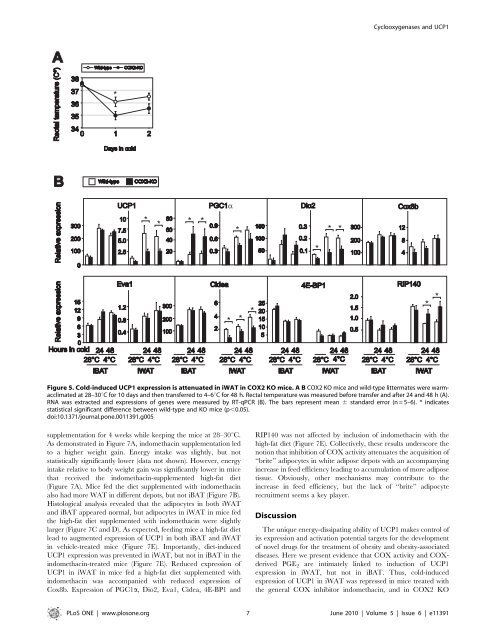The obesogenic effects of polyunsaturated fatty acids are dependent ...
The obesogenic effects of polyunsaturated fatty acids are dependent ...
The obesogenic effects of polyunsaturated fatty acids are dependent ...
Create successful ePaper yourself
Turn your PDF publications into a flip-book with our unique Google optimized e-Paper software.
Cyclooxygenases and UCP1<br />
Figure 5. Cold-induced UCP1 expression is attenuated in iWAT in COX2 KO mice. A B COX2 KO mice and wild-type littermates were warmacclimated<br />
at 28–30uC for 10 days and then transferred to 4–6uC for 48 h. Rectal temperature was measured before transfer and after 24 and 48 h (A).<br />
RNA was extracted and expressions <strong>of</strong> genes were measured by RT-qPCR (B). <strong>The</strong> bars represent mean 6 standard error (n = 5–6). * indicates<br />
statistical significant difference between wild-type and KO mice (p,0.05).<br />
doi:10.1371/journal.pone.0011391.g005<br />
supplementation for 4 weeks while keeping the mice at 28–30uC.<br />
As demonstrated in Figure 7A, indomethacin supplementation led<br />
to a higher weight gain. Energy intake was slightly, but not<br />
statistically significantly lower (data not shown). However, energy<br />
intake relative to body weight gain was significantly lower in mice<br />
that received the indomethacin-supplemented high-fat diet<br />
(Figure 7A). Mice fed the diet supplemented with indomethacin<br />
also had more WAT in different depots, but not iBAT (Figure 7B).<br />
Histological analysis revealed that the adipocytes in both iWAT<br />
and iBAT appe<strong>are</strong>d normal, but adipocytes in iWAT in mice fed<br />
the high-fat diet supplemented with indomethacin were slightly<br />
larger (Figure 7C and D). As expected, feeding mice a high-fat diet<br />
lead to augmented expression <strong>of</strong> UCP1 in both iBAT and iWAT<br />
in vehicle-treated mice (Figure 7E). Importantly, diet-induced<br />
UCP1 expression was prevented in iWAT, but not in iBAT in the<br />
indomethacin-treated mice (Figure 7E). Reduced expression <strong>of</strong><br />
UCP1 in iWAT in mice fed a high-fat diet supplemented with<br />
indomethacin was accompanied with reduced expression <strong>of</strong><br />
Cox8b. Expression <strong>of</strong> PGC1a, Dio2, Eva1, Cidea, 4E-BP1 and<br />
RIP140 was not affected by inclusion <strong>of</strong> indomethacin with the<br />
high-fat diet (Figure 7E). Collectively, these results underscore the<br />
notion that inhibition <strong>of</strong> COX activity attenuates the acquisition <strong>of</strong><br />
‘‘brite’’ adipocytes in white adipose depots with an accompanying<br />
increase in feed efficiency leading to accumulation <strong>of</strong> more adipose<br />
tissue. Obviously, other mechanisms may contribute to the<br />
increase in feed efficiency, but the lack <strong>of</strong> ‘‘brite’’ adipocyte<br />
recruitment seems a key player.<br />
Discussion<br />
<strong>The</strong> unique energy-dissipating ability <strong>of</strong> UCP1 makes control <strong>of</strong><br />
its expression and activation potential targets for the development<br />
<strong>of</strong> novel drugs for the treatment <strong>of</strong> obesity and obesity-associated<br />
diseases. Here we present evidence that COX activity and COXderived<br />
PGE 2 <strong>are</strong> intimately linked to induction <strong>of</strong> UCP1<br />
expression in iWAT, but not in iBAT. Thus, cold-induced<br />
expression <strong>of</strong> UCP1 in iWAT was repressed in mice treated with<br />
the general COX inhibitor indomethacin, and in COX2 KO<br />
PLoS ONE | www.plosone.org 7 June 2010 | Volume 5 | Issue 6 | e11391
















